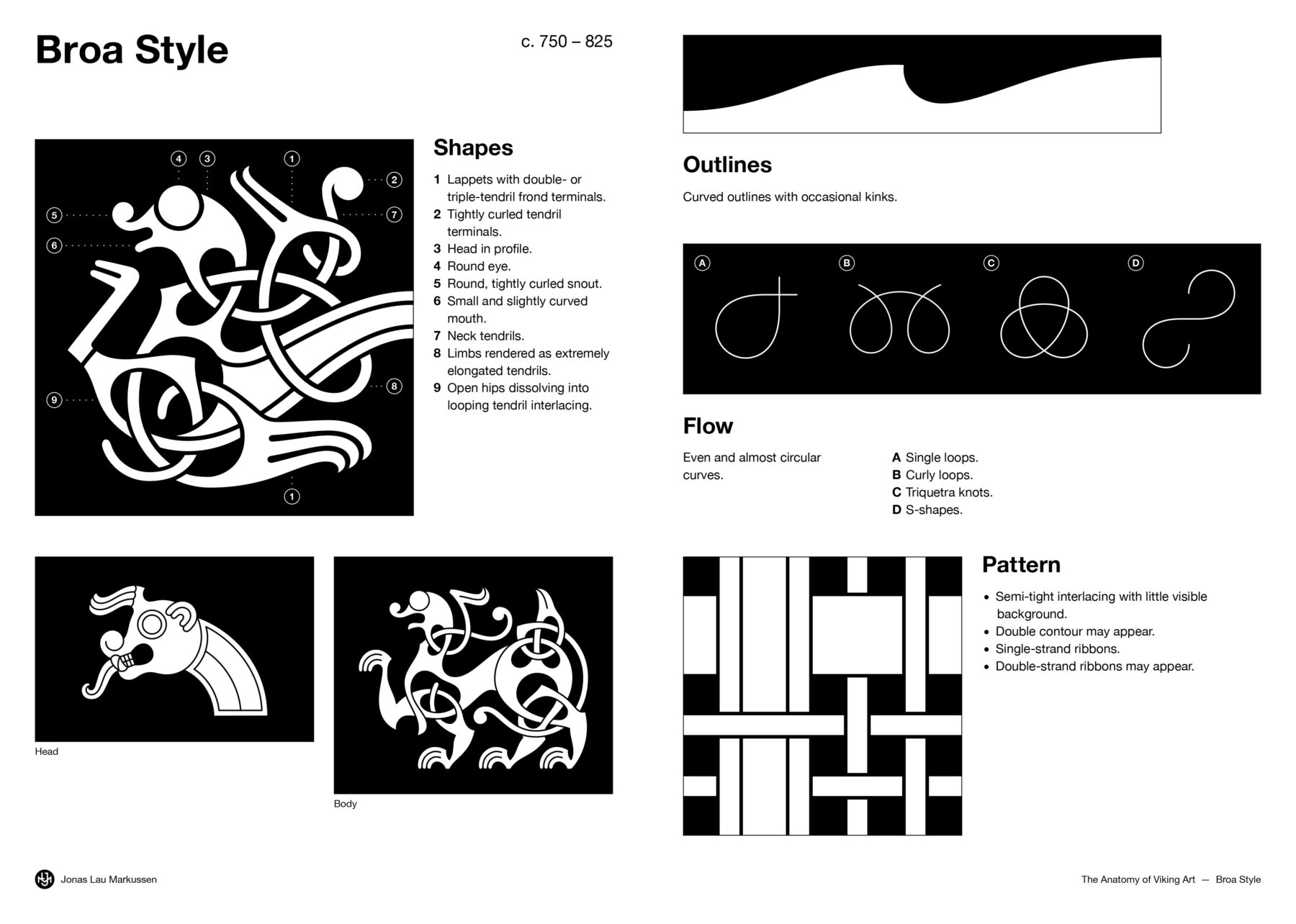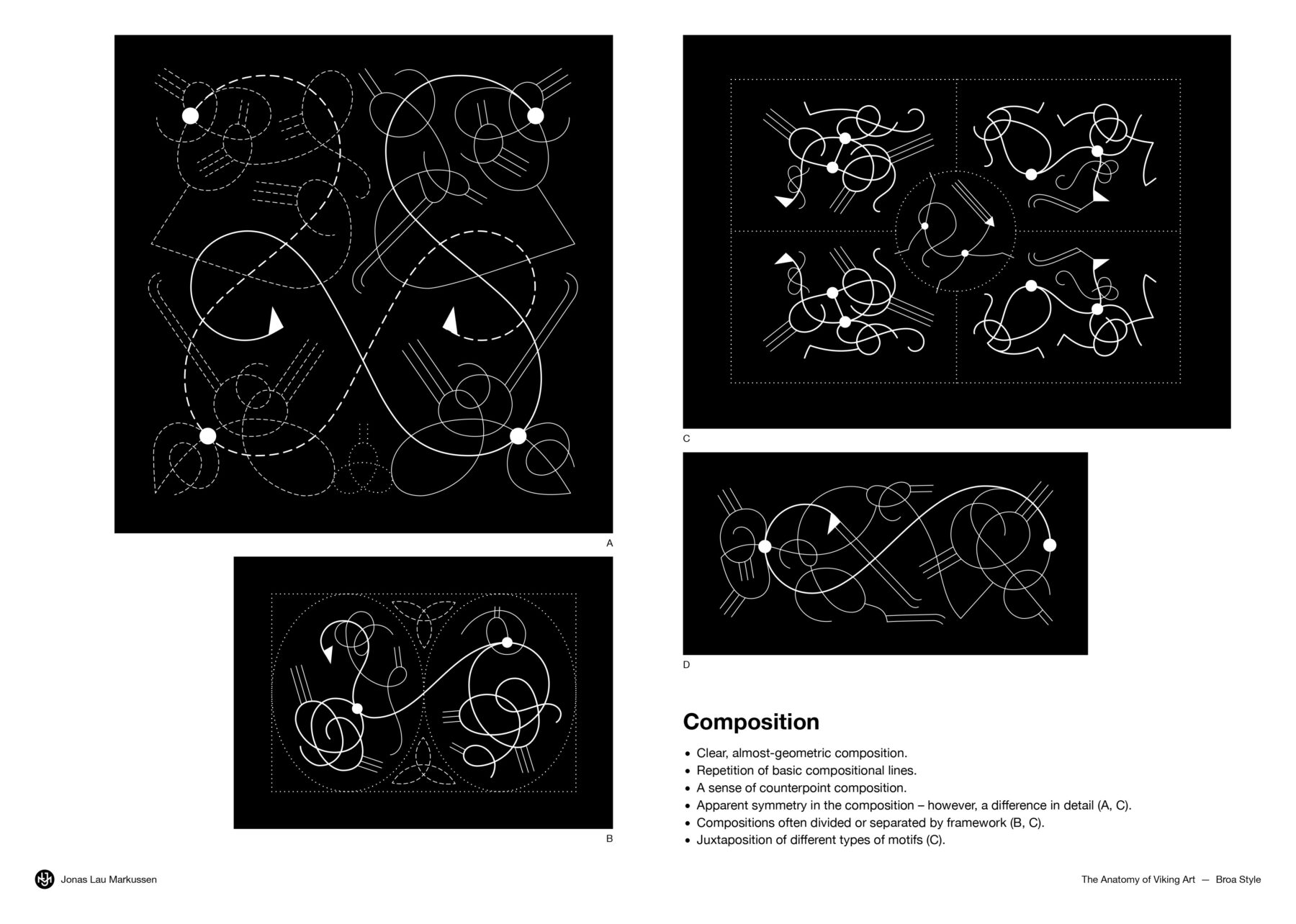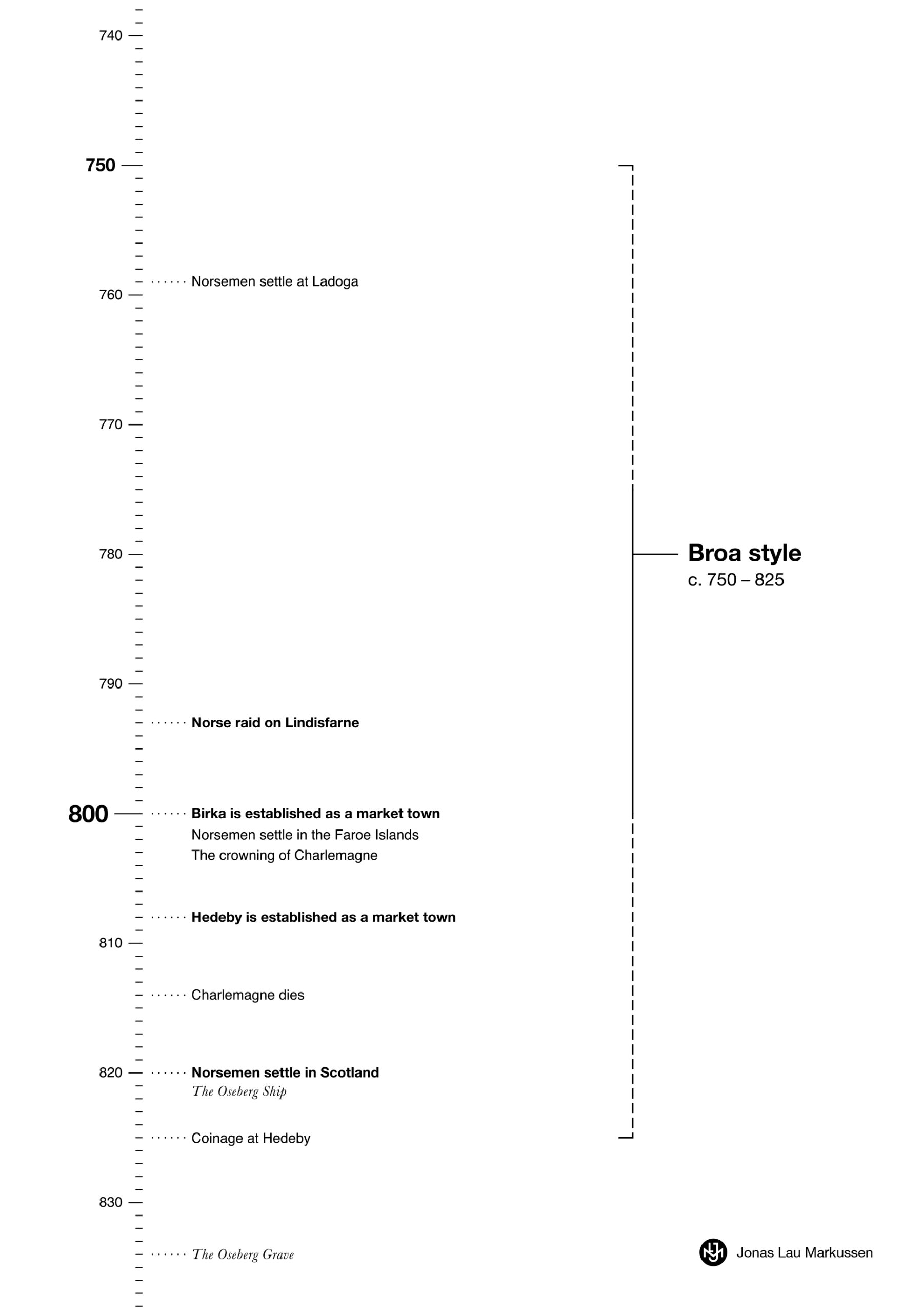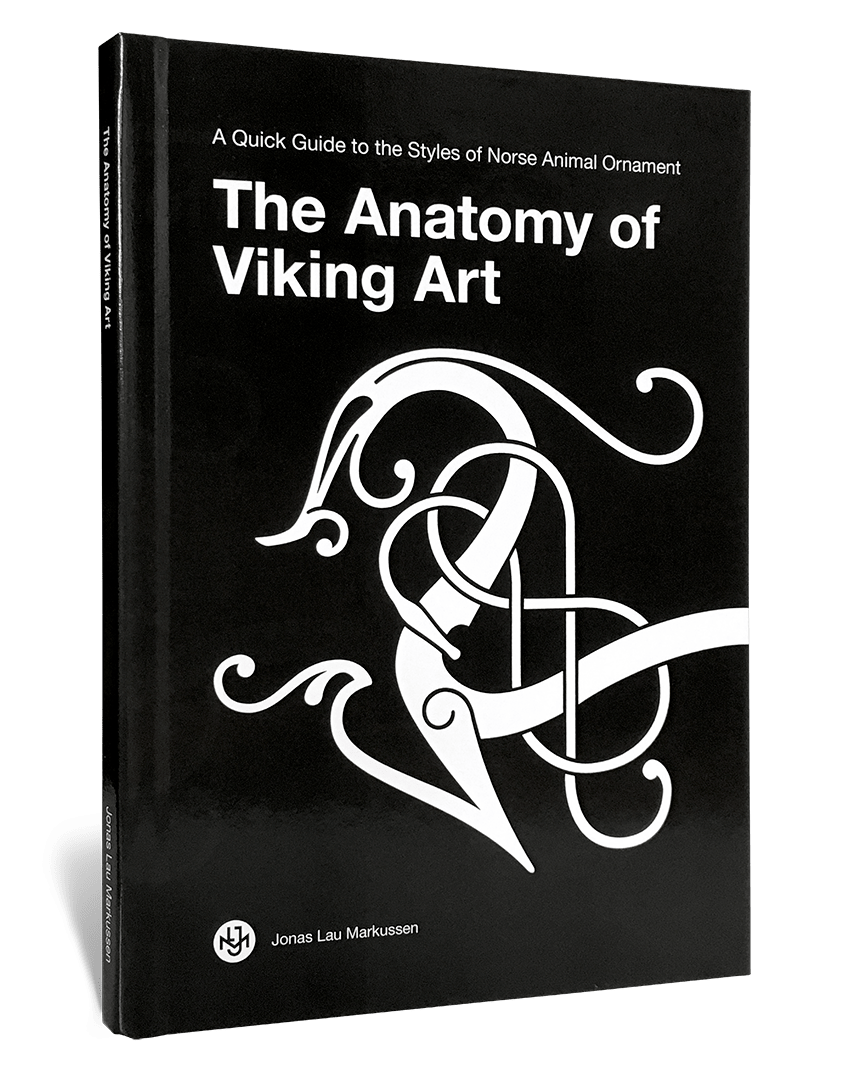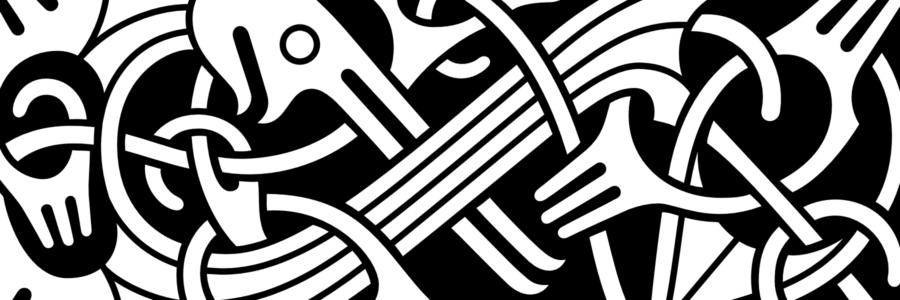
Broa Style
December 20, 2016
The Anatomy of Viking Art
- Introduction
- Broa Style
- Oseberg Style
- Borre Style
- Jelling Style
- Mammen Style
- Ringerike Style
- Urnes Style
The Anatomy of the Broa Style
c. 750 – 825
Shapes
1. Lappets with double- or triple-tendril frond terminals.
2. Tightly curled tendril terminals.
3. Head in profile.
4. Round eye.
5. Round, tightly curled snout.
6. Small and slightly curved mouth.
7. Neck tendrils.
8. Limbs rendered as extremely elongated tendrils.
9. Open hips dissolving into looping tendril interlacing.
Outlines
Curvy outlines with occasional kinks.
Flow
Even and almost circular curves.
A. Single loops.
B. Curly loops.
C. Triquetra knots.
D. S-shapes.
Pattern
- Semi-tight interlacing with little visible background.
- Double contour may appear.
- Single-strand ribbons.
- Double-strand ribbons may appear.
Composition
- Clear, almost-geometric composition.
- Repetition of basic compositional lines.
- A sense of counterpoint composition.
- Apparent symmetry in the composition – however, a difference in detail (A, C).
- Compositions often divided or separated by framework (B, C).
- Juxtaposition of different types of motifs (C).
Motifs
- Ribbon animals with elongated bodies and extremely stylised features (A, B, D).
- Squat animals with more naturalistic bodies (B, C).
- Gripping beasts with solid bodies, ribbon-like bodies and expanded hips, and slender limbs gripping the frame or neighbouring animals or limbs (C).
- Geometric framework (B, C).
Dawn of the Viking Age
Scandinavia
Life in early Viking-age Scandinavia was centred largely around the longhouses of the farmsteads, either clustered in small villages or as single farms in the open countryside. Power structures varied, but usually a chieftain wielded the central power in local communities that comprised a number of farmsteads that swore allegiance to the chieftain. Spiritual practices were inherent to all aspects of life, and did not centre around any single religious institution such as the Christian Church. Tribute was paid to the various Norse deities, such as Odin, Freya and Thor, and whom it was of paramount importance to please with fitting sacrifices to ensure good fortune, depending on the matter at hand. The establishment of trading towns such as Hedeby and Birka typically began with temporary and seasonal marketplaces in conjunction with yearly communal thing assemblies that functioned as both parliaments and courts. The marketplace was typically made up of a collection of allotments along each side of the main street, with booths for commerce and makeshift workshops. These seasonal marketplaces quickly developed into more established market towns where trade could be controlled and taxes collected by the local ruler. The southern border of Scandinavia was marked by Danevirke, a fortification running across the narrowest part of the Jutland peninsula, with Hedeby at the east end, which controlled all land access to Scandinavia from the south, and connected the land trade routes with those of the sea. The gradual establishment of controlled trading towns and military structures of this magnitude indicates that some kind of ruling power, such as a king, organising and controlling subordinate chieftains and their resources, must have already been established by this time.
Europe
In the British Isles, the various Christian territories were divided into a number of kingdoms. Western Continental Europe was dominated by the expansive Frankish Empire, supported by the Catholic Church. The empire reached its peak around the year 800, when the Pope crowned Charlemagne of the Carolingian dynasty Holy Roman Emperor in Rome. Eastern Continental Europe was inhabited by a large population of Slavic clans and tribes, whose way of life and spiritual beliefs much more closely resembled those of the Norse people of Scandinavia.
Connections and Exchange
The concept of travelling and exchanging goods throughout Europe, by sea and land, was not new to the Norse, but the introduction of the sail at the beginning of the Viking Age made their already magnificent ships much faster, and therefore able to travel further. This new advantage was one of the reasons the Norse now began to be a force to be reckoned with, and they ultimately left a lasting and profound impression on European history. Though most of the journeys and exchanges of the Norse were probably relatively peaceful and based on trading goods and establishing alliances and connections, the Scandinavians are best known for their violent raids. The term ‘viking’ means ‘pirate’ in Old Norse, and was not the general name for the peoples of Scandinavia, but was used only when individuals or groups were ‘going viking’, that is, going pirating. In the surrounding Europe of their time, the Scandinavians were often better known as ‘the Norse’ or some equivalent that denoted their origins, such as ‘Swedes’ or ‘Danes’. In the written sources, the most famous account of the Norse is the viking attack on the Monastery of Lindisfarne, on the east coast of England. This event marks what scholars traditionally regard as the beginning of the Viking Age in Scandinavia.
Ribbon Animals & Gripping Beasts
Development
The Scandinavian artistic traditions of this time were already well-established, and several iterations of the Norse trademark, the ribbon animal, had been in use for a few centuries. The ribbon animals of the Broa style cover a spectrum of motifs and styles of execution. Common characteristics are heads in profile with round eyes, and open hips with intertwining, ribbon-like limbs. At one end of the spectrum, the animals are extremely abstracted, with elongated bodies, simplified facial features, and completely uniform limbs, whether they depict claws, wings or tendrils intertwined in almost geometric patterns. At the other end of the spectrum, the animals are almost naturalistic, with organic and squat bodies, while they maintain many of the characteristic features of this style. They are often pictured individually, with the only interlacing of ribbons being their own intertwining limbs. The gripping beast, on the other hand, does not adhere at all to conventions of ribbon animals. It is always pictured with its head facing forward, and its body is typically curled up in a single pretzel-knot-like interlacing, with solid hips. Its feet always grasp either itself or the surrounding frame of the ornament. The individual motifs themselves, whether ribbon animals or gripping beasts, are almost always surrounded by, or interlace with, a geometric framework, typically ovals or squares that hold together the composition. The British Isles were an artistic centre at this time, but the Norse also felt the influence of the Anglo-Carolingian art of the Frankish regions. In particular, the semi-organic animals and birds must have derived from European art in some way, as they do not seem to have any predecessors in Scandinavian tradition, though they were developed dramatically to fit it, and it is almost impossible to trace them back to their European sources of inspiration. The motif of the gripping beast that emerges in the Broa style may also have been somehow inspired by these external sources, but at the same time, it is a distinctly Norse motif, developed within the Scandinavian tradition, with no direct precursors outside of Scandinavia.
Dating
Dating early Viking Age art styles is difficult, and rests partly on the typology of objects and partly on related, dateable Anglo-Carolingian ornaments, which means that any distinctions should be viewed with caution.
The Broa Mounts
The Broa style is popularly named for the horse-harness mounts found in Broa, Sweden, but is formally known as Style III/E or just Style E. The Broa mounts display a comprehensive collection of almost all imaginable compositions and motifs of this style, with the occasional gripping beast added to the mix, and include some motifs not found elsewhere, such as the animal-head pieces and almost-human-like terminals on some of the mounts.
Disc-on-bow Brooches
The various disc-on-bow brooches typically display the more abstracted and elongated versions of the ribbon animals of this style, juxtaposed with segments of gripping beast motifs.
The Oseberg Academician’s Work
The so-called Academician’s work from the Oseberg grave displays some fine examples of wood carving in this style, though they may be on the cusp of transitioning into the subsequent Oseberg style.
Distribution
The Broa style is found only in Scandinavia, and is especially common in eastern Scandinavia.
Examples
Dateable
c. 834
The Lion Head Animal-head post — the Oseberg Grave
Oseberg, Vestfold, Norway.
Kulturhistorisk Museum, Oslo, C55000/172.
c. 834
The Academician’s Animal-head Post — the Oseberg Grave
Oseberg, Vestfold, Norway.
Kulturhistorisk Museum, Oslo, C55000/100.
c. 834
The Academician’s Sledge Pole — the Oseberg Grave
Oseberg, Vestfold, Norway.
Kulturhistorisk Museum, Oslo, C55000/227.
Undateable
Animal-shaped brooch
Lamøen, Vestfold, Norge.
Kulturhistorisk Museum, Oslo C27220/n
Box Brooch — Allekvia *
Allekvia, Gotland, Sweden.
Historiska Museet, Stockholm, 1140064.
Box Brooch — Gotland *
Gotland, Sweden.
Gotlands Museum, Visby, GFC91.
Box Brooch — Nygårda *
Nygårda, Gotland, Sweden.
Historiska Museet, Stockholm, 449105.
Box Brooch — Smiss *
Smiss, Gotland, Sweden.
Historiska Museet, Stockholm, 3004041.
Box Brooch — Suderbys *
Suderbys, Gotland, Sweden.
Historiska Museet, Stockholm, 449158.
Box Brooch — Öja *
Öja, Gotland, Sweden.
Historiska Museet, Stockholm, 449121.
Disc-on-bow Brooch — Broa
Broa, Gotland, Sweden.
Historiska Museet, Stockholm, 106557.
Disc-on-bow Brooch — Gumbalda
Gumbalda, Gotland, Sweden.
Historiska Museet, Stockholm, 362429.
Disc-on-bow Brooch — Melhus T40
Melhus, Trøndelag, Norway.
NTNU Vitenskapsmuseet, Trondheim, Oslo, T40.
Disc-on-bow Brooch — Melhus T41
Melhus, Trøndelag, Norway.
NTNU Vitenskapsmuseet, Trondheim, Oslo, T41.
Disc-on-bow Brooch — Orre *
Orre, Rogaland, Norway.
Universitetsmuseet i Bergen, Bergen, B2559.
Disc-on-bow Brooch — Othemars
Othemars, Gotland, Sweden.
Historiska Museet, Stockholm, 453312.
Disc-on-bow Brooch — Nylund *
Nylund, Rogaland, Norway.
Universitetsmuseet i Bergen, Bergen, B488.
Horse Harness Mounts
Broa, Gotland, Sweden.
Historiska Museet, Stockholm, 107213.
Mount *
Hämeenlinna, Kanta-Häme, Finland.
Kansallismuseo, Helsinki, KM8615:9.
Openwork Mount
Othem, Gotland, Sweden.
Historiska Museet, Stockholm, 107265.
Oval Brooch
Södra Alby, Gotland, Sweden.
Historiska Museet, Stockholm, 1089990.
Sword
Steinsvik, Troms, Norway.
Kulturhistorisk Museum, Oslo, C20317.
Sword Hilt
Stora Ihre, Gotland, Sweden.
Historiska Museet, Stockholm, 471597.
* Examples added to the list in 2023.
Examples removed from the list in 2023
- Oval Brooch. Gesala, Västmanland, Sweden. Historiska Museet, Stockholm, 39381.
- Round ‘box-shaped’ brooch (I). Valla, Gotland, Sweden. Historiska Museet, Stockholm.
- Round ‘box-shaped’ brooch (II). Klause, Klinte sn., Gotland, Sweden. Historiska Museet, Stockholm GF C 8099.
- Round ‘box-shaped’ brooch (III). Gotland, Sweden. Historiska Museet, Stockholm GF C 3506.
Litterature
Graham-Campbell, James, 2013. Viking Art.
Fuglesang, Signe Horn, 1982. ‘Early Viking Art.’ Acta ad Archaeologiam et Artium Historiam Pertinentia (Series altera in 8°) 125–173.
